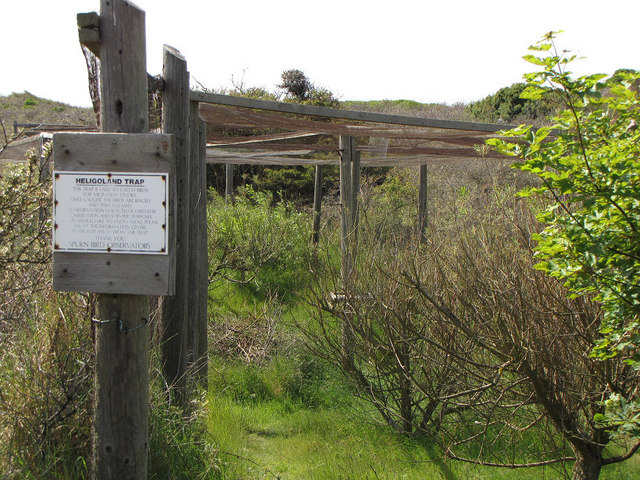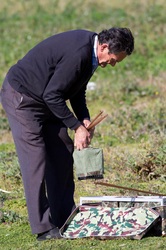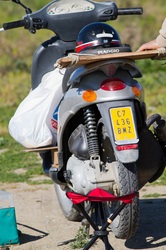Bird Trapping
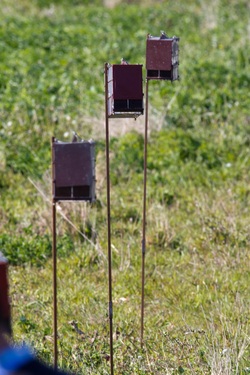
Goldfinches held in individual cages
In my last blog I referred to a visit last Sunday morning, 26 February, to the Rio Velez, Torre del Mar with my brother-in-law Chris Sprinks and Stephen Powell during which, as we approached the growing fields to the east of the river, came across a “Bird Trapper” at 11.30 in the process of removing his equipment. At the time it looked most suspicious, especially given his anxiety when he realised that we were taking photographs of himself along with his equipment and scooter, which was clearly displaying the registration plate. The man, when asked, had insisted he had a permit from the Junta and the birds were not for eating! Upon my return home, not only did I try and find out more information about the stated legality of his action but, sadly, came across so many incidents of illegal trapping in most parts of Europe, never mind the Middle East and some of the poorer parts of Africa and Asia.
The following is not intended as some definitive account of Bird Trapping but, rather, an outline of some of the reasons why we catch birds in the wild. On completion, I will return to our Spanish friend and his activities last Sunday morning. However, please remember that the views expressed are mine alone and do not represent any other body or organisation.
There are three main reasons for catching birds and these can be loosely summarised as (i) Scientific, (ii) Food and (iii) Commerce and/or Pleasure. In addition, we must also not forget that man’s main interaction with our bird life is for the purpose of killing, whether this be for sport (mainly by shooting) or culling to remove a perceived or potential threat to human life.
Millions of birds are shot each year by hunters and in our western democracies these are usually game and wildfowl which are shot under licence and with strict shooting conditions and pre-determined seasons. However, let us not be naive. Many other birds are shot in our European countries with, shamefully, either connivance or lack of protection and, in some cases, even EEC laws get “bypassed” as individual nations, including France and Spain, maintain that they are protecting ancient customs and traditions. Is Britain above such action? Of course not as we still regularly see reported instances of game-keepers removing raptors (usually by baited poison) and there are still a number of ooliologists (egg collectors) and others removing chicks from the nest for onward sale. The other reason for killing is, according to officials, to prevent disease so we see examples such as the mass culling of pigeons in some of our inner cities, removal of birds considered a pest (who makes these decisions?), the decision to try and eradicate the Ruddy Duck from Britain and northern Europe to prevent it inter-breeding with the rare White-headed Duck and so protect the latter as a pure species. Forty years ago there was a mass cull of Bullfinches in Britain to protect our fruit orchards and we all know the sorry state of our present Bullfinch population.
Perhaps the worst case scenario is when both these aspects come together as one and we see the mass extermination of our migrant bird in such notorious cases as that currently happening in both Malta and Cyprus. Where is the political will to uphold legislation and put a stop to the slaughter of anything that flies and with over a million birds shot in Cyprus last autumn? But back to our main topic, the trapping of birds, and the suggested three main reasons.
Scientific
For the past hundred years serious scientific studies have been undertaken to try and determine all sorts of activities including longevity, migration patterns, disease, measurements to help with our greater understanding of how birds develop, etc. To successfully undertake these activities birds need to be actually caught and handled before safe release back into the wild. The individuals who undertake these activities receive proper training and work under specific licences issued by the appropriate authorities, usually on a national basis. This helps ensure that the welfare of the bird is always paramount.
The following is not intended as some definitive account of Bird Trapping but, rather, an outline of some of the reasons why we catch birds in the wild. On completion, I will return to our Spanish friend and his activities last Sunday morning. However, please remember that the views expressed are mine alone and do not represent any other body or organisation.
There are three main reasons for catching birds and these can be loosely summarised as (i) Scientific, (ii) Food and (iii) Commerce and/or Pleasure. In addition, we must also not forget that man’s main interaction with our bird life is for the purpose of killing, whether this be for sport (mainly by shooting) or culling to remove a perceived or potential threat to human life.
Millions of birds are shot each year by hunters and in our western democracies these are usually game and wildfowl which are shot under licence and with strict shooting conditions and pre-determined seasons. However, let us not be naive. Many other birds are shot in our European countries with, shamefully, either connivance or lack of protection and, in some cases, even EEC laws get “bypassed” as individual nations, including France and Spain, maintain that they are protecting ancient customs and traditions. Is Britain above such action? Of course not as we still regularly see reported instances of game-keepers removing raptors (usually by baited poison) and there are still a number of ooliologists (egg collectors) and others removing chicks from the nest for onward sale. The other reason for killing is, according to officials, to prevent disease so we see examples such as the mass culling of pigeons in some of our inner cities, removal of birds considered a pest (who makes these decisions?), the decision to try and eradicate the Ruddy Duck from Britain and northern Europe to prevent it inter-breeding with the rare White-headed Duck and so protect the latter as a pure species. Forty years ago there was a mass cull of Bullfinches in Britain to protect our fruit orchards and we all know the sorry state of our present Bullfinch population.
Perhaps the worst case scenario is when both these aspects come together as one and we see the mass extermination of our migrant bird in such notorious cases as that currently happening in both Malta and Cyprus. Where is the political will to uphold legislation and put a stop to the slaughter of anything that flies and with over a million birds shot in Cyprus last autumn? But back to our main topic, the trapping of birds, and the suggested three main reasons.
Scientific
For the past hundred years serious scientific studies have been undertaken to try and determine all sorts of activities including longevity, migration patterns, disease, measurements to help with our greater understanding of how birds develop, etc. To successfully undertake these activities birds need to be actually caught and handled before safe release back into the wild. The individuals who undertake these activities receive proper training and work under specific licences issued by the appropriate authorities, usually on a national basis. This helps ensure that the welfare of the bird is always paramount.
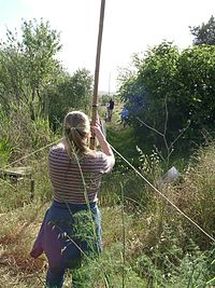
Mist nets being erected
The birds themselves are caught in a number of ways but, mainly, by the use of Mist Nets. These are similar to large butterfly nets with a very fine mesh and stretched between poles/canes and can vary in length from twenty to sixty feet (6 to 20 metres). Naturally, the length can be extended by joining nets together. Most mist nets are usually about ten feet (3m) high and consist of five taught strings of nylon so that the net produces a natural overlap of material on the lower tension string. Being almost invisible, the bird flies into the soft mesh and then lies suspended in a pocket below the tension string until carefully and safely removed for processing. This last aspect will probably include taking body weight, wing length measurement and checking for signs of moulting and existing body fat levels. Either at the start or end of the process an individually numbered alloy ring will be placed on the bird’s leg and then the bird released.
This is the basic process but there are numerous variations. For instance, some organisations may be undertaking specific studies, such as migration, where they need to follow the routes taken but not necessarily re-catch individual birds. In this case it may be possible to also fix a plastic ring of a predetermined number of colours and/or letters and/or numbers so that the bird can be identified in the field, usually requiring the use of binoculars or a telescope. This is particularly useful on larger birds including Spoonbills, geese, flamingos and even birds of prey and gulls. Indeed, at a local level, such studies have also been undertaken to help study the movement of Robins.
This is the basic process but there are numerous variations. For instance, some organisations may be undertaking specific studies, such as migration, where they need to follow the routes taken but not necessarily re-catch individual birds. In this case it may be possible to also fix a plastic ring of a predetermined number of colours and/or letters and/or numbers so that the bird can be identified in the field, usually requiring the use of binoculars or a telescope. This is particularly useful on larger birds including Spoonbills, geese, flamingos and even birds of prey and gulls. Indeed, at a local level, such studies have also been undertaken to help study the movement of Robins.
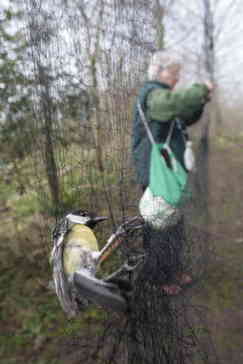
Further variations of the trapping process can also include the use of Cannon Nets to capture birds such as waders when they move up off the beach onto nearby fields to roost at high tide. In this case the nets are set well in advance whilst the birds are feeding at low tide. Assuming the birds duly arrive at the appropriate site, a small charge is ignited so that the nets are fired up and over the resting flock to catch the maximum number of birds in a single attempt. Obviously, there is no second chance if the birds decided to rest at a different location or not within the safe limits of the set net. I have seen these used most successfully at both Morecombe Bay and the Wash.
Another large scale trapping process is the Heligoland Trap such as that at the Spurn Observatory in Humberside. This is a large man-made funnel of supported fencing that encourages the bird to enter naturally. The birds then work their way down to the narrow end of the funnel where they can be trapped and safely removed for processing.
Heligoland Trap, Spurn Point
The notice advises that this network of posts and mesh is devised to trap migrating birds so that they can be recorded and ringed, without harming them.
Another large scale trapping process is the Heligoland Trap such as that at the Spurn Observatory in Humberside. This is a large man-made funnel of supported fencing that encourages the bird to enter naturally. The birds then work their way down to the narrow end of the funnel where they can be trapped and safely removed for processing.
Heligoland Trap, Spurn Point
The notice advises that this network of posts and mesh is devised to trap migrating birds so that they can be recorded and ringed, without harming them.
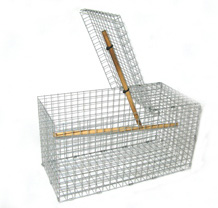
Working in confined spaces to catch specific birds it is also possible with the use of a Chardonnay Trap. Here it is a question of the individual dropping into a small cage to feed on the provided food. As soon as the bird lands on the perch at the bottom the trap door is released and the bird caught.
As already stated, all the above work is done under licence and follows specific training by experts to ensure that all the processes are fully understood. Indeed, specific endorsements to the licence are required to undertake some of the above netting methods.
This trap is readily available for purchase over the Internet!
As already stated, all the above work is done under licence and follows specific training by experts to ensure that all the processes are fully understood. Indeed, specific endorsements to the licence are required to undertake some of the above netting methods.
This trap is readily available for purchase over the Internet!
Food
The second reason that man catches birds is to feed himself and his family or sell his catch to others for the same reason. This then brings a possible philosophical problem to the equation. However, in western Europe, aside from the hunting angle there are supposed to be strict rules governing the taking of wild birds. In theory all are protected but we still see instances of thousands of birds caught for slaughter that end up on the dinner table. It is still possible to come across, usually very rural, restaurants selling a meal of small song birds.
The people eating these birds as a “delicacy” have probably o idea of the barbaric ways in which these birds are caught. The local hunter will know how the birds move about and then often use a “call bird” in a small cage to encourage birds down to ground level. Then, when happily exploring the bird song, they either fly into a small mist net set low to the ground or, even worse, land on or get caught by one of the many sticky lime sticks that have been placed n the vicinity. With their wings stuck to the lime and unable to escape, the birds panic and get into an even worse state. A painful, miserable death of stress and starvation follows or a snap of the neck when found by the trapper. After that it is a question of throwing the bodies into a bag for transport home.
This, again, is one grey area where individual countries in the EEC have tried to argue that limited catching should continue as it is part of the native culture in certain areas. Another case of all agreeing to the same cause but this is an exception for our area/country!
One very worrying aspect that became very clear during my Internet searches is the ready availability of mist nets and traps for sale to the public, whether for legal or illegal purposes.
Commerce/Pleasure
This is a difficult area to define and includes those who take wild birds to keep for themselves as, possibly, pets. I use the word “pets” in its widest meaning as it can include falconers who keep birds for hunting and those who enjoy bird song and want, for example, a lovely male Goldfinch instead of a Canary in the cage hanging in their house or out on the balcony. The former are usually taken from the nest just before they are ready to fledge whilst song birds are normally caught by the use of traps and already caged calling birds to attract the wild birds down as above. Once the birds are sold on to others, either by way of local shops and markets or to predetermined orders for a specific birds then pleasure takes on the role of commerce. And very big business it is too in the case of birds of prey with very large sums of money exchanging hands in the Middle East for specific raptors.
Closer to home in southern Spain
The following is taken direct from the website of Andalucia which promotes all things local (http://www.andalucia.com/rural/hunting.htm) and might now be compared with how Spain, as a nation, was called to account in 1998 by the European Court with regard one of the oldest EEC initiatives, the Wild Birds Directive.
Present entry on Andalucia website: Birds hunted
The Spanish red-leg partridge is the most popularly hunted bird. Also plentiful are turtledoves, wood pigeons, quails, pheasants, thrushes and starlings, all of which are hunted to eat, in addition to water species, such as various species of ducks and snipes.
When did you last see or hear a Quail and how many Turtle Doves do you come across during the summer months?
Extract from the EEC 1998 response:
Commission reacts against Spain regarding the hunting season for wild birds in Ceuta
The European Commission has decided to notify a Reasoned Opinion under Article 169 of the EC Treaty against Spain for the failure of hunting practice in Ceuta to comply with the hunting provisions of the European Union's (EU) Wild Birds Directive (Council Directive 79/409/EEC on the conservation of wild birds). In particular, the hunting of quails and turtle doves during the migration period is authorised by the local authorities in Ceuta year after year, contrary to the Directive. While the authorisations are consistently challenged and overturned before the competent authorities and the Spanish courts, this happens too late to stop hunting during a period when it should not be allowed.
As with so many aspects of Spanish life, it seems too often a case of, “Surely this does not apply to us?” and, even if it did, who is going to monitor, let alone take action, against such practices?
The second reason that man catches birds is to feed himself and his family or sell his catch to others for the same reason. This then brings a possible philosophical problem to the equation. However, in western Europe, aside from the hunting angle there are supposed to be strict rules governing the taking of wild birds. In theory all are protected but we still see instances of thousands of birds caught for slaughter that end up on the dinner table. It is still possible to come across, usually very rural, restaurants selling a meal of small song birds.
The people eating these birds as a “delicacy” have probably o idea of the barbaric ways in which these birds are caught. The local hunter will know how the birds move about and then often use a “call bird” in a small cage to encourage birds down to ground level. Then, when happily exploring the bird song, they either fly into a small mist net set low to the ground or, even worse, land on or get caught by one of the many sticky lime sticks that have been placed n the vicinity. With their wings stuck to the lime and unable to escape, the birds panic and get into an even worse state. A painful, miserable death of stress and starvation follows or a snap of the neck when found by the trapper. After that it is a question of throwing the bodies into a bag for transport home.
This, again, is one grey area where individual countries in the EEC have tried to argue that limited catching should continue as it is part of the native culture in certain areas. Another case of all agreeing to the same cause but this is an exception for our area/country!
One very worrying aspect that became very clear during my Internet searches is the ready availability of mist nets and traps for sale to the public, whether for legal or illegal purposes.
Commerce/Pleasure
This is a difficult area to define and includes those who take wild birds to keep for themselves as, possibly, pets. I use the word “pets” in its widest meaning as it can include falconers who keep birds for hunting and those who enjoy bird song and want, for example, a lovely male Goldfinch instead of a Canary in the cage hanging in their house or out on the balcony. The former are usually taken from the nest just before they are ready to fledge whilst song birds are normally caught by the use of traps and already caged calling birds to attract the wild birds down as above. Once the birds are sold on to others, either by way of local shops and markets or to predetermined orders for a specific birds then pleasure takes on the role of commerce. And very big business it is too in the case of birds of prey with very large sums of money exchanging hands in the Middle East for specific raptors.
Closer to home in southern Spain
The following is taken direct from the website of Andalucia which promotes all things local (http://www.andalucia.com/rural/hunting.htm) and might now be compared with how Spain, as a nation, was called to account in 1998 by the European Court with regard one of the oldest EEC initiatives, the Wild Birds Directive.
Present entry on Andalucia website: Birds hunted
The Spanish red-leg partridge is the most popularly hunted bird. Also plentiful are turtledoves, wood pigeons, quails, pheasants, thrushes and starlings, all of which are hunted to eat, in addition to water species, such as various species of ducks and snipes.
When did you last see or hear a Quail and how many Turtle Doves do you come across during the summer months?
Extract from the EEC 1998 response:
Commission reacts against Spain regarding the hunting season for wild birds in Ceuta
The European Commission has decided to notify a Reasoned Opinion under Article 169 of the EC Treaty against Spain for the failure of hunting practice in Ceuta to comply with the hunting provisions of the European Union's (EU) Wild Birds Directive (Council Directive 79/409/EEC on the conservation of wild birds). In particular, the hunting of quails and turtle doves during the migration period is authorised by the local authorities in Ceuta year after year, contrary to the Directive. While the authorisations are consistently challenged and overturned before the competent authorities and the Spanish courts, this happens too late to stop hunting during a period when it should not be allowed.
As with so many aspects of Spanish life, it seems too often a case of, “Surely this does not apply to us?” and, even if it did, who is going to monitor, let alone take action, against such practices?
Velez Malaga
So what of the individual that we came across last Sunday? In this case, the man was using ten individually caged Goldfinches. Each bird was in a very small wire cage mounted at the top of a 4 foot post in two rows of five cages each. Whilst there was no sign of trapping cages and/or mist nets, take a look at the large bundle already on his scooter. Could this be a bag of nets? If so, where were the birds or how was he storing the birds for transport if not already dead? Certainly, there were no other cages visible other than the ten calling cages which we watched him carefully cover and place into two larger carrying boxes. Those, the bags and the poles were all going to be transported on his little scooter; perhaps he was also going to collect his wife and shopping on the way home!
So what of the individual that we came across last Sunday? In this case, the man was using ten individually caged Goldfinches. Each bird was in a very small wire cage mounted at the top of a 4 foot post in two rows of five cages each. Whilst there was no sign of trapping cages and/or mist nets, take a look at the large bundle already on his scooter. Could this be a bag of nets? If so, where were the birds or how was he storing the birds for transport if not already dead? Certainly, there were no other cages visible other than the ten calling cages which we watched him carefully cover and place into two larger carrying boxes. Those, the bags and the poles were all going to be transported on his little scooter; perhaps he was also going to collect his wife and shopping on the way home!
Trapper placing (5) individual cages into carrying box Scooter for carrying trapper's equipment. What do you think might be in the carrier bag?
Acknowledgements:
The photographs of nets and traps were found by searching the Internet and, where appropriate, suitable acknowledgement is recorded.
Note: Re the photograph of the Spurn Heligoland Trap:
© Copyright George Robinson and licensed for reuse under this Creative Commons Licence
The local photographs at Velez Malaga were taken by my birding friend, Stephen Powell
The following two links will provide the reader with more information about illegal bird trapping, shooting, etc.
http://www.conservation.org.cy/birds.htm (Re the Cyprus Killing Fields)
http://www.satellites.co.uk/forums/meeting-place/194421-cyprus-estimated-395-000-birds-killed-illegally-using-mist-nets-lime-sticks.html (Link to illegal trapping)
Bob Wright
1 March 2012
1 March 2012
